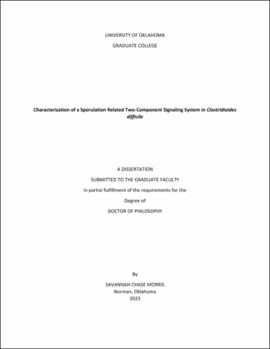| dc.description.abstract | Clostridioides difficile is a spore-forming anaerobic human pathogen, that is commonly associated with antibiotic therapy in adults. The disturbance of the gut microbiota, typically caused by antibiotics, allows for an environment in which this bacterium can grow and cause an infection (CDI). C. difficile produces spores that are dormant, and resistant to antibiotics and common disinfecting methods. These spores are the mode of transmission for this bacteria since they contaminate surfaces and are ingested to infect their hosts. The pathways that regulate the process of sporulation, or spore formation, are still poorly characterized and the initiation of this process still isn’t fully understood.
Two-component systems are present in bacteria, fungi, and plants where they function to sense and adapt to environmental conditions to ensure survival. These systems in bacteria have previously been linked to motility, virulence, cell division, sporulation, and many other essential biological processes. The histidine kinase within the system detects the environmental conditions and signals for the response regulator to provide a specific response such as DNA binding, enzymatic reactions, quorum sensing, etc.. In the C. difficile hypervirulent strain CDR20291, there are 54 response regulators and 57 histidine kinases, but not all of these have been characterized, including response regulator CD1688 and histidine kinase CD1689 which were previously predicted to be involved in sporulation.
This dissertation presents data about a sporulation-related two-component system in C. difficile. Following the introductory chapter, Chapter 2 characterizes the regulatory effect the system composed of RR CD1688 and HK CD1689 has on sporulation. This characterization demonstrated that CD1688 is a negative regulator of sporulation. Chapter 3 further investigates this negative regulator by identifying the specific steps in which activation of CD1688 represses sporulation.
Together the findings from these studies have provided additional insight into the sporulation pathway, and these insights could be exploited for the development of new treatments. | en_US |

